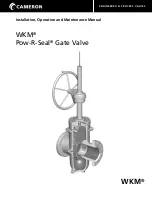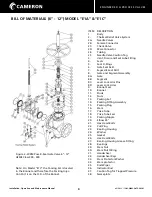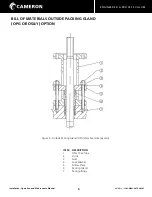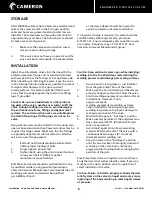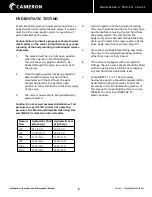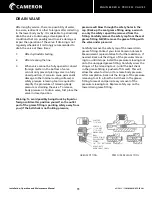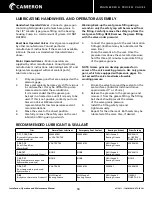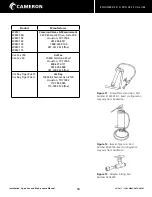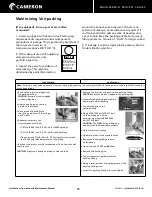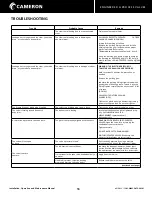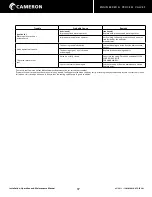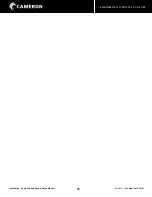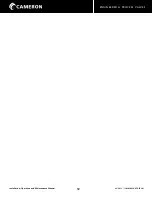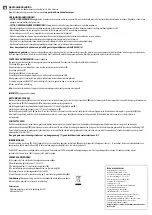
E N G I N E E R E D & P R O C E S S V A L V E S
8
02/2011 / IOM-WKM-GATE-PRS-01
Installation, Operation and Maintenance Manual
STORAGE
After WKM Pow-R-Seal Gate Valves are assembled and
tested, the valves are left in the full open position,
seats and bores are greased and end protectors are
installed. These measures will provide protection for
approximately six months. The following care should
be taken when storing valves:
1.
Make sure the valve end connection covers
remain in place during storage.
2.
If the valve does not have an operator and the
valve will be stored outside, the exposed stem
or the stem adapter should be covered to
avoid accumulation of water and debris.
If long-term storage is required, the valve should be
conditioned by following Cameron procedure
X-150771-01. Ensure adequate end connection covers
are in place. Request a copy of X-150771-01 from
Cameron’s Valves & Measurement group.
INSTALLATION
Install Pow-R-Seal Gate Valves into the line with the
preferred pressure flange end or weld end (marked
with red paint from the factory) as the upstream side.
When handling or installing the valve, keep the valve
in the full open position whenever possible to prevent
foreign matter damage to the gate and seat
sealing surfaces. The valve should be lifted in such
a way that the body supports the load or use lifting
lugs, if provided.
Caution: Do not use handwheels or other protrud-
ing parts of the valve, gearbox or actuator to lift the
valve. During handling, use care to avoid damaging
the end connection faces, fittings and bypass relief
systems. The end connection necks are suitable places
to attach lifting slings, if lifting lugs are not on the
valve.
Flanged-End valves may be bolted into line using two
open or boxed end wrenches. Power wrenches may be
required for larger valves. Make sure the line flanges
are properly aligned and will not distort or bind the
valve. Use new flange gaskets.
1.
Bolt and nut threads should be lubricated to
obtain proper loading of bolts.
2.
Finger-tighten all nuts first.
3.
Tighten bolts, using the crisscross method and
torque each bolt to ASME or gasket
manufacture’s specifications.
Butt Weld-End Valves should be welded into the line
by qualified welders, using qualified procedures.
Cameron Valves & Measurement recommends that all
welding procedures and welders be qualified
per ASME Section IX.
Caution: Keep weld end valves open while installing/
welding into the line. Weld slag created during the
welding process could damage gate sealing surfaces.
1.
Use solvent to clean grease or rust inhibitor
from the gate and/or bore of the valve.
2.
Make sure the line and valve weld bevels are
properly aligned, and will not bind the valve.
3.
Electric welding equipment is preferred for all
installations. However, if only
oxygen-acetylene
welding equipment is available, extreme
caution should be taken regarding excess
welding temperature to prevent damage to
sealing components of the valve.
4.
Weld with the gate in “Full Open” position.
5.
Make sure temperature of the body/seat area
does not exceed 250°F. (Check with Tempil
stick or equivalent).
6.
Avoid rapid application of excess welding
material. Weld each end of the valve with a
continuous bead using a 1/8” maximum
diameter electric welding rod.
7.
Keep the valve in the “Full Open” position
until the line has been thoroughly cleaned of
weld slag in the valve bore and line (by
pigging and/or flushing) before changing the
position of the gate.
Pow-R-Seal Gate Valves in liquid service must have a
body thermal relief system (needle valves, if present,
must be in the open position prior to operation of
valve) installed on the valve.
Caution: Failure to install a properly set body thermal
relief system on the valves in liquid service may cause
rupturing of the body resulting in catastrophic release
of pressure.

